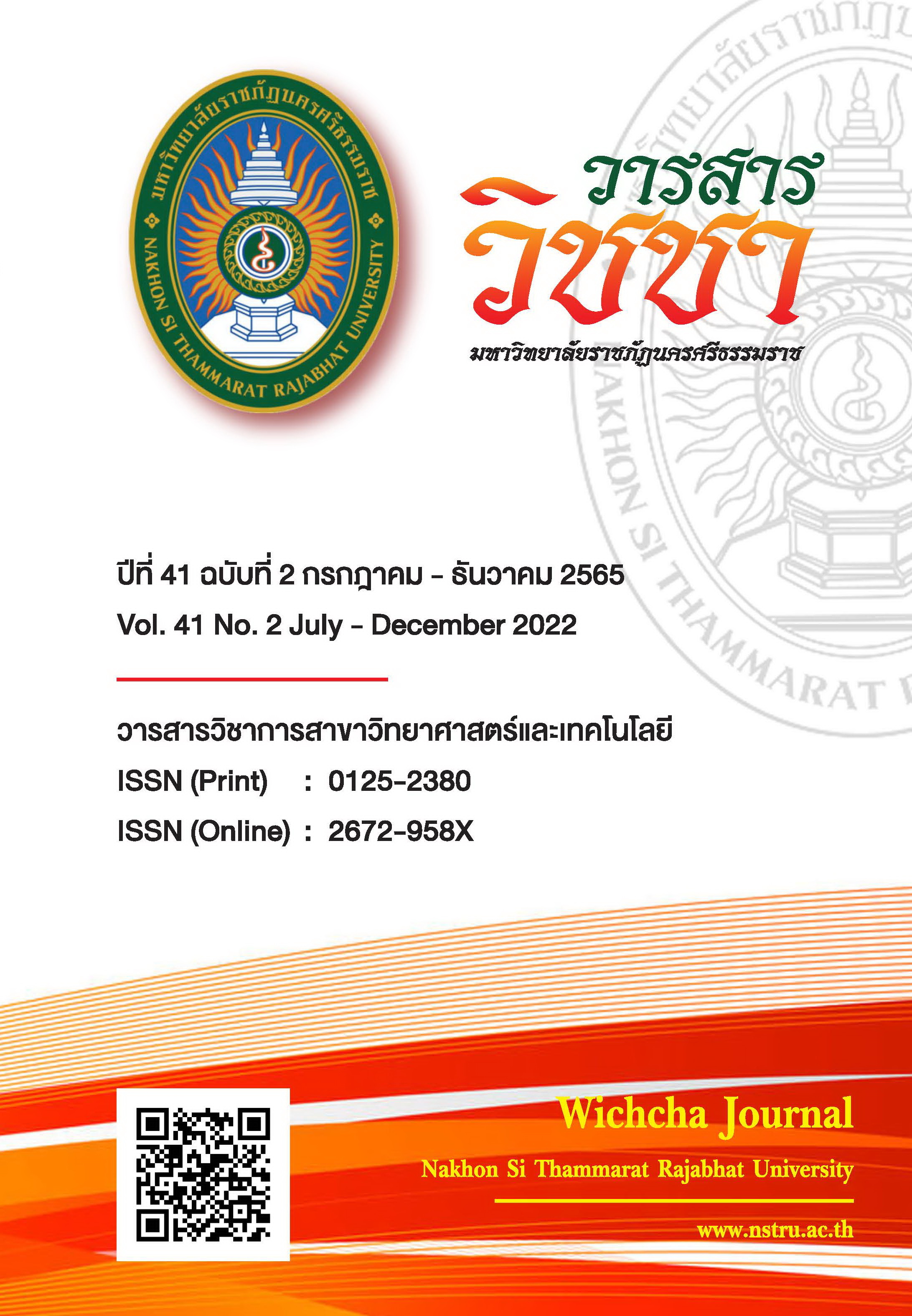Prototype Development of a Semi-automatic Latex Mixer
Main Article Content
Abstract
This research is to develop a prototype of a semi-automatic rubber latex mixer. The objective of this work aims to reduce labor usage and reduce the working time of rubber farmers. As well as increase the accuracy of mixing the rubber. The working system of the latex mixer is semi-automatic which uses the principle of measuring latex, water (H2O), and formic acid (CH2O2) in the mixing tank with the ingredients. There is a quantity that the user has set. The command will be sent to the Motor to blend all the ingredients together. Then the mixed rubber latex will be released into Takong (Mold tray) prepared. From the test of the measurement accuracy in the mixing tank Part 1 in the test of the measurement accuracy in the rubber and water mixing tank, it was found that if the latex was released into the tank the volume. Volume of the semi-automatic latex mixer is 2.75 kg percent, the tolerance of the Para rubber will be 0.25 and if water is put into the 2.25 kg of the semi-automatic latex mixer, the percentage tolerance of the rubber will be equal to 1.18. Part 2 is a mixture of latex and water. In the amount equal to 5 kg, then 0.06 kg of formic acid was released and the experiment was carried out 10 times and the percentage tolerance was 0.60%. 1st and 2nd place averaged 2.55 s and 2.57 s, respectively. It takes less time to mix and tolerance is an acceptable value making it possible to save time in working, including helping to reduce labor in mixing parasol as well.
Article Details

This work is licensed under a Creative Commons Attribution-NonCommercial-NoDerivatives 4.0 International License.
เนื้อหาและข้อมูลในบทความที่ลงตีพิมพ์ในวารสารวิชชา มหาวิทยาลัยราชภัฏนครศรีธรรมราช ถือเป็นข้อคิดเห็นและความรับผิดชอบของผู้เขียนบทความโดยตรง ซึ่งกองบรรณาธิการวารสารไม่จำเป็นต้องเห็นด้วยหรือร่วมรับผิดชอบใด ๆ
บทความ ข้อมูล เนื้อหา รูปภาพ ฯลฯ ที่ได้รับการตีพิมพ์ในวารสารวิชชา มหาวิทยาลัยราชภัฏนครศรีธรรมราช ถือเป็นลิขสิทธ์ของวารสารวิชชา มหาวิทยาลัยราชภัฏนครศรีธรรมราช หากบุคคลหรือหน่วยงานใดต้องการนำข้อมูลทั้งหมดหรือส่วนหนึ่งส่วนใดไปเผยแพร่ต่อหรือเพื่อการกระทำการใด ๆ จะต้องได้รับอนุญาตเป็นลายลักษณ์อักษรจากวารสารวิชชา มหาวิทยาลัยราชภัฏนครศรีธรรมราชก่อนเท่านั้น
The content and information in the article published in Wichcha journal Nakhon Si Thammarat Rajabhat University, It is the opinion and responsibility of the author of the article. The editorial journals do not need to agree. Or share any responsibility.
References
กองวิจัยเศรษฐกิจยาง ฝ่ายเศรษฐกิจยาง การยางแห่งประเทศไทย. (2565). สถานการณ์ยางพาราเดือนมีนาคม 2565. สืบค้นเมื่อ 15 เมษายน 2565, จาก: http://www.raot.co.th/ewt_dl_link.php?nid=5659.
คณะกรรมการนโยบายยางธรรมชาติ. (2552). ยุทธศาสตร์พัฒนายางพารา. สืบค้นเมื่อ 2 มิถุนายน 2565, จาก: http://rubber.oie.go.th/box/ELib_Document/.2552-2556.pdf.
คณะกรรมาธิการการเกษตรและสหกรณ์สภานิติบัญญัติแห่งชาติ. (2562). ภาพรวมของยางพาราทั้งระบบ. รายงานการพิจารณาศึกษา. สำนักเลขาธิการวุฒิสภา.
ณัฐพงศ์ นิธิอุทัย นันทวัฒ ช่วยค้ำ และเสาวนีย์ ก่อวุฒิกุลรังษี. (2547). ผลความหนืดของน้ำยางฟองน้ำ. รายงานวิจัย. มหาวิทยาลัยสงขลานครินทร์.
นิภาส ลีนะธรรม วีระยุทธ สุดสมบูรณ์ ฉัตรชัย แก้วดี และอดิศร ไกรนรา. (2562). การลดเวลาสูญเสียในกระบวนการทดสอบปริมาณสิ่งสกปรกในยางแท่งด้วยแนวคิดลีนซิกซ์ซิกม่า: กรณีศึกษาโรงงานผลิตยางแท่ง. วารสารวิชชา มหาวิทยาลัยราชภัฏนครศรีธรรมราช, 38(2), 104-119.
วิเชียร เกตุสิงห์. (2541). สถิติวิเคราะห์สำหรับการวิจัย. (พิมพ์ครั้งที่ 4). กรุงเทพฯ: ไทยวัฒนาพานิช.
วิทยาลัยทองสุข. (2556). การหาค่าเฉลี่ย. รายงานการประเมินความพึงพอใจของผู้ใช้บริการสารสนเทศสำหรับบุคลากร วิทยาลัยทองสุข ปีการศึกษา 2556. วิทยาลัยทองสุข.
สถาบันวิจัยยาง. (2554). การแปรรูปผลิตภัณฑ์จากน้ำยางพารา. กรุงเทพฯ: สถาบันวิจัยยาง กรมวิชาการเกษตร กระทรวงเกษตรและสหกรณ์.
สำนักงานพัฒนาการวิจัยการเกษตร (องค์การมหาชน). (2552). ฐานข้อมูลงานวิจัยยางพารา. สืบค้นเมื่อ 12 เมษายน 2565, จาก: http://agknowledge.arda.or.th/rubber.
สำนักงานเศรษฐกิจอุตสาหกรรม. (2564). สถานการณ์อุตสาหกรรมยางและผลิตภัณฑ์ยาง ไตรมาสที่ 3 (กรกฎาคม-กันยายน) ปี 2564. สืบค้นเมื่อ 14 เมษายน 2565, จาก: https://www.raot.co.th/download/pdf/predict_rubber_economy_3_64.pdf.


